|
1/32 Fw 190A-8 backdated
to an A-7
Sturmbock!
|
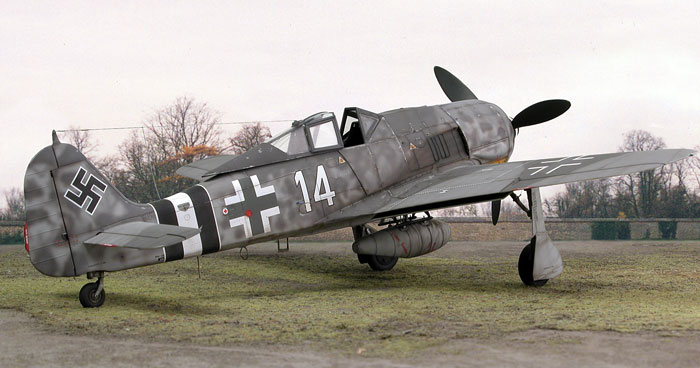 |
|
Focke-Wulf Fw 190A-7 Sturmbock |
Painting and Exterior
Detailing by
Chris Wauchop
Built and Converted by Brett
Green

Hasegawa's 1/32 scale Focke-Wulf Fw 190A-8 is available online from Squadron.com
Hasegawa's new 1/32 scale Fw 190A-8 in the box
In April
2004, almost exactly a year since the release of their new-tool large
scale Dora, Hasegawa launched a 1/32 scale Focke-Wulf Fw 190A-8.
112 grey plastic parts are supplied on 11 sprues. Four of these sprues
are common to last year's Fw 190D-9 kit, including the wings and
undercarriage gear. As a result, there are 24 parts not used on this
first Butcher Bird version.
All the parts are beautifully presented in shiny plastic with crisply
engraved panel lines. Texture on control surfaces comprises fine raised
lines. I like this low-key approach.
Probably in the interests of simplicity, the cooling vents on the
fuselage sides are moulded shut. Cockpit detail is adequate, but some
modellers will want to enhance this area. The engine is supplied as a
single part moulded with both rows of cylinders. This is not really a
problem because not much can be seen behind the cooling fan once the
model is finished. Even so, Hasegawa has moulded an ignition harness
onto the front of the cylinders, and also included a separate part with
pushrods. These look good when painted carefully
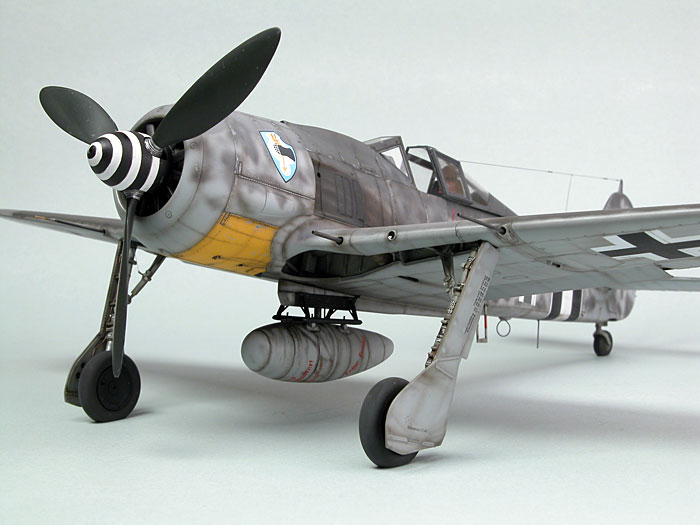
Unlike the Dora, the Fw 190A had a fully enclosed wheel well. The kit
wheel well part is attached to the wing spar, ensuring the correct
dihedral. The characteristic dimples in the top of the wheel well are a
little too cylindrical - they should look more like the dimples on a
golf ball. There are also a few ejector pin marks to deal with on the
gear bay and covers.
The late-style smooth drop tank from the Dora remains in this box, in
addition to a new standard 300 litre tank. Although the drop tank in
Hasegawa's 1/32 scale was quite good, this new version is poorly shaped
and inaccurate in detail
Options are few. The landing flaps are separate parts and may be
depicted dropped, but the locating tabs need to be repositioned as the
flaps are dropped too far without modification. Two styles of lower
access panel and ejector chute for the outer wing 20mm cannon position
are offered.
Only the early, flat canopy is included in this kit but it is
beautifully thin and free of optical distortion.
In summary,
despite the couple of nit-picks, Hasegawa's new tool 1/32 scale
Focke-Wulf Fw 190A-8 really is an excellent and attractive kit.
Cockpit and Basic Construction
As usual, construction commenced in the cockpit. I used the kit
components for the front office, but added MDC instrument decals to the
kit instrument panel and an MDC photoetched brass harness to the seat.
I like the MDC instrument decals because they are printed as
individual decals with minimal carrier film, and the white dial detail
is quite crisp and legible. The brass MDC harness is quite effective
too.
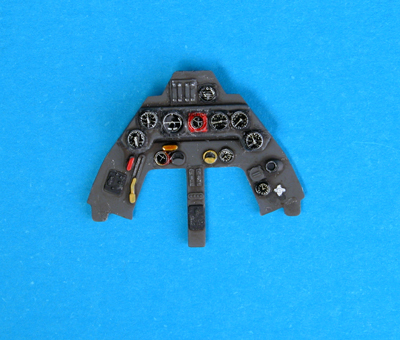
Basic construction went fairly smoothly, but I confess
that assembling the five-part nose assembly was not enjoyable. Test
fitting suggested that the fit was going to be awful, but it did not
turn out too badly. There were some alignment problems around the lower
sides of the cowl resulting in a small step between the nose and the
main fuselage, but this step appears to be present in wartime photos of
Wurgers too.
Click the
thumbnails below to view larger images:
|
|

|
|
An MDC photo-etched brass harness was used on the kit seat. |
|

|
|
MDC's 1/32 scale instrument decals were used on the kit instrument panel |
|
|
|
|
Backdating to a Fw 190A-7
Sturmbock
I was inspired to build a Focke-Wulf 190A-7 after
receiving Cutting Edge Decals' CED32055 - Fw 190s Part 2.
This new release includes a striking Sturmbock
of Sturmstaffel 1, White 14, with a Black/White/Black RV band, a
tight white spinner spiral and a blotchy RLM 74/75/76 grey finish.
Almost as interesting as the markings was the extra armour on the
fuselage sides, canopy and windscreen. To my eyes, these additions
made the squat lines of the Butcher Bird look even more purposeful.
Apart from these obvious additions, backdating to
the A-7 variant required a number of further modifications. After
consulting various books and plans, I formed my final plan using
John
Beaman's excellent Wurger Genesis article in HyperScale's Reference
Library. John's article outlines the progressive differences
between Focke-Wulf Fw 190 variants.
The Fw 190A-7 was dimensionally identical to the
later A-8. However, the Fw 190A-8 had a number of improvements and
additions that needed to be changed or eliminated:
-
On the Fw 190A-8,
the ETC carrier was moved 8 inches forward. I therefore drilled
new locating holes for the carrier approximately 4mm behind the
indicated positions, and shortened the rear section of the rack
by the same amount..
-
The outline of the
large, rounded hatch on the bottom of the fuselage was filled
and sanded smooth. This hatch provided access to the MW50 gear,
which was not present on the A-7. Another panel was removed from
the starboard fuselage side, the fuel filler hatch was
relocated, and a further hatch filled and smoothed on the port
side of the fuselage. I used Liquid Paper as the filler for
these panels, followed by Gunze Mr Surfacer to ensure that no
ghosts of the outlines remained.
-
I drilled out holes
for the wing cannon bulges before I remembered that these were
not installed on the A-7 (unless it was fitted with 30mm
outer-wing cannon). I plugged the holes with plastic rod,
puttied the area and sanded it smooth.
-
The pitot tube was
relocated from its position on the wing tip to mid-wing.
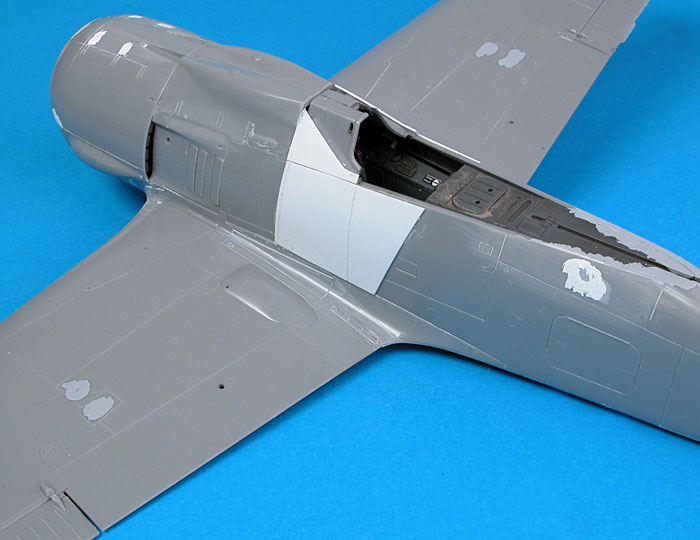
Fuselage armour was cut from .020" plastic card. It is important to
use glue sparingly when securing the armour to the kit fuselage, as
excessive amounts could melt or distort the thin plastic.
I replaced the inaccurate kit drop tank with the parts from a 1/32
scale Hasegawa Bf 109G-6 kit. The end cone was cut off the tank,
which was typical for Wurgers. The resulting hole was filled and
sanded smooth.
I did miss one detail. Noted Luftwaffe researcher John Beaman
contacted me after the model was completed to say that the cowling
zues fasteners on the upper front cowl are not all three
"down" as I have depicted them. That configuration was first
introduced on the A-8. The A-7 had the front two on the "top" panel
as per the A-5 and 6 and the rearmost one down like the A-8.
Click the
thumbnails below to view larger images:
|
|

|
|
Various filler and access hatches need to be filled when backdating Hasegawa's Fw 190A-8 to an A-7. |
|

|
|
On the Fw 190A-7, the ETC carrier was located 8" aft of the position on the Fw 190A-8. The kit carrier was modified and installed in the appropriate position. Also note the filled MW50 hatch in the bottom of the fuselage |
|
|
Armoured Canopy Glass
The next conversion duty was to create the armoured
glass panels for the canopy. The framing around these panels was
quite distinctive. There appears to be a wide, flat internal frame
and a narrower rounded border.

After considerable thought I decided to cut thin
clear acetate to the shape of the panels, then glue thin strips of
the same material as the wide frame. I bought a pack of .040"
half-round Evergreen strip styrene to represent the outer frames.
The strips were measured, bevelled and carefully glued in place with
super glue.
The Baton is
Passed...
At this stage I handed the model to Chris
Wauchop.
His first task was to add subtle rivet
detail to the fuselage and wings. On the fuselage, including the side
armour, Chris used a needle in a pin vise to individually drill each
rivet hole. He used a small Pounce Wheel to speed the process on the
larger wing surfaces.
The model was then sprayed with Gunze
acrylic RLM 02 to make sure that the rivets were consistent and that the
filled panel lines were truly eliminated. Chris re-filled and re-sanded
several panels before proceeding.
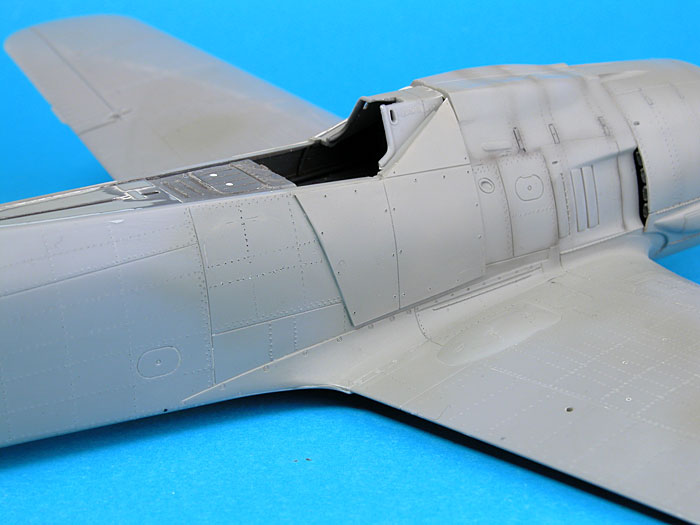
Click the
thumbnails below to view larger images:
More Modifications and
Additions
Chris made a number of enhancements and additions to
the basic kit:
-
The gun camera port
in the leading edge of the port wing was enlarged and a lens was
added using Krystal Kleer and Tamiya Smoke acrylic paint.
-
The ports for the
20mm outer wing cannon were hollowed out and the barrels
replaced with brass tube.
-
Landing gear
indicators were added to the upper wing from brass wire.
-
Landing gear
actuating struts were fabricated from stretched sprue, and fine
electrical wire was attached to the struts, using fine
electrical wire!
-
Brake lines were
added from solder.
-
The drop tank and
rack were detailed including
-
supporting
struts
-
locking pins
-
fuel lines x 2
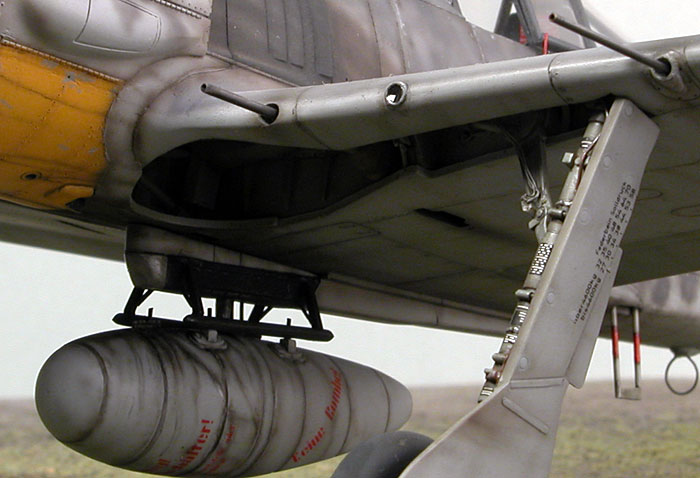
-
Exhaust stacks were
hollowed out (I started to do this but chickened out!)
-
The kit tyres were
flattened.
-
The tailwheel was
partially retracted using
the method
described in Chris's 2003 Fw 190D-9 Feature Article.
-
Radio antenna wire and
the reinforcing wires inside the canopy were added using invisible
mending thread.
-
The angle of the landing
flaps was altered by cutting off the tabs and thinning the under
surface of the wings to permit the flaps to sit against the trailing
edge of the wings.
-
The missing section of
instrument coaming was replaced with scrap plastic.
-
A DF loop was formed
from a staple, and the trailing IFF antenna from brass wire. These
are much more robust than the plastic kit parts
Camouflage
 The
model was painted using the Testor Aztek A470 airbrush fitted with the
fine tan tip. The
model was painted using the Testor Aztek A470 airbrush fitted with the
fine tan tip.
Chris used Gunze acrylics - RLM 74, 75 and 76 - for the
camouflage colours. The RLM 75 was lightened slightly with white to
increase the contrast between the two upper surface shades.
Tamiya Flat Yellow acrylic, mixed with a drop of Gloss
Red, was sprayed on the lower cowl..

The armoured glass panels on the inside of the
windscreen were simulated by painting wide, dark grey frames on the
inside of the kit part. These were further emphasised by painting a fine
light grey line around the border of the frames on the outside of the
windscreen.
The front sun shield on the Revi gunsight was painted
Gunze Clear Green mixed with a drop of Gunze Clear Red to reduce the
bright tone.
Chris used his usual weathering techniques, including
post-shading panel lines with a thinly sprayed mix of Tamiya acrylic Red
Brown and Black. Wing walks, cowl panels and the canopy were also
"chipped" using the point of a silver artist's pencil.
Prior to applying decals, Chris polished the surface of
the model with a fine cloth. This removed some paint from the raised
lips of the rivet holes, adding subtle emphasis.

Markings
Cutting Edge Decals' item number CED32055, "Fw 190s Part
2" were used for the aircraft numbers and national markings. The decals
performed perfectly, settling down nicely into panel lines.
Chris found that the spinner spiral was too short to
depict the tight pattern on the real aircraft, so he painted it himself.
The spinner was first sprayed white, then masked with thin strips of
Tamiya tape, and oversprayed with black. The result was uneven, so some
more time was spent with a fine brush to achieve a tidier outcome.
Stencil markings were sourced from an EagleCals 1/32
scale Fw 190D sheet.
Hasegawa has adopted a consistent strategy of designing their new
1/32 scale kits to be accurate in outline, simple to build, reasonably
detailed and affordable. Indeed, their recent Fw 190D-9 and Bf 109 kits
have not been fitted with astonishing detail, multimedia parts, movable
control surfaces, retracting undercarriage, flashing lights or engine
sounds.
They have, instead, focused on the basics; and modellers have built
these kits in extraordinary numbers.
Hasegawa's new 1/32 scale Focke-Wulf Fw 190A-8 and Fw 190A-5 kits
maintain this approach.
After-market companies have embraced 1/32 scale with a flood of updates,
conversions, alternate markings and improved parts for modellers who
want a more detailed result. We already have a good selection of decals
and detail sets for Hasegawa's new Wurger, and I am certain there will
be plenty more to come.
Congratulations Hasegawa. In my opinion (for all that is worth),
you have found the magic formula for bringing joy to the heart of the
New Age Luftwaffe Modeller!
Photography
The composite images were created in Photoshop CS using
images of the model and of background photos taken by myself last year
at Duxford, and by George Pfromm in Germany and Belgium several years
ago.
The model was photographed on a base of artificial grass and dirt
against a plain grey background.
The backgrounds were modified by adjusting brightness, contrast, hue,
saturation, plus removing and relocating foliage and other features.
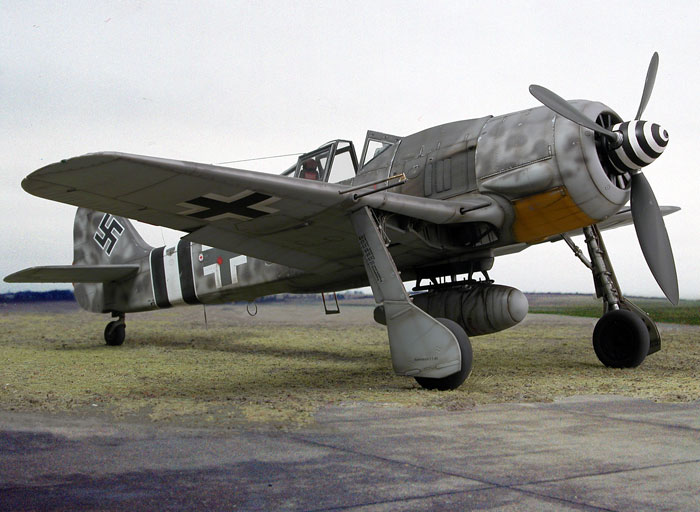
Returning to the Fw 190A-7 photo, the model and part of the grass base were
masked using Photoshop's Magic Wand and Lasso tools, then cut from the
original image.
The model was then pasted as a new layer onto the
modified background. Extra work was done merging the model photo with
the background, especially around the canopy (through which the
background was visible) and around the edges of the aircraft. Where the
outline of the model was stark against the background image, the Blur
and Gaussian Blur tools were used to blend it in.
The Clone Stamp and Healing
Brush tools were used in a few places to blend the the artificial grass
with the real concrete runway.
Finally, the composite images were cropped, resized to 700 pixels in
width, and saved as a .jpg file for posting on HyperScale.
All the photos were taken with my Nikon Coolpix 5700 digital camera.
Click the
thumbnails below to view larger images:
Focke-Wulf Fw 190
Modelling Manuals 20 |
|
|
|
|
US Price: $17.95
UK Price: £12.99
Publisher:
Osprey Publishing
Publish Date:
May 25, 2002
Details: 64 pages; ISBN: 1841762687 |
|
|
Model by Chris Wauchop &
Brett Green
Images & Text Copyright © 2004 by
Brett Green
Page Created 04 September, 2004
Last Updated
08 September, 2004
Back to
HyperScale Main Page |
Home
| What's New |
Features |
Gallery |
Reviews |
Reference |
Forum |
Search